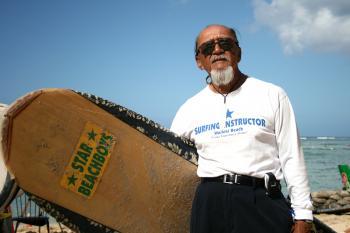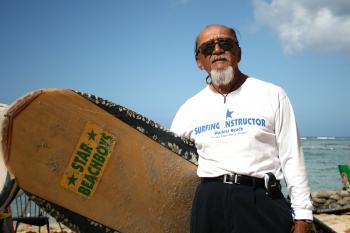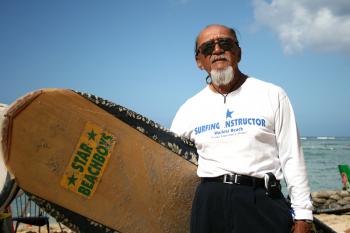HONOLULU, HI—If you visit Waikiki beach in Honolulu in search of a place to surf, you’re likely to see a statue of an imposing, yet friendly man—Duke Kahanamoku—the most well known surfer in the world.
Although Duke passed away in 1968, his statue is always laden with piles of leis (flower garlands) left by respectful visitors. The statue marks a location where surfing history was made by Duke and other beach boys, culture was passed down, and young generations of surfers learned the traditions of surfing and the Hawai’ian spirit of Aloha.
The original beach boys in the 1940s provided beach services in front of the only two hotels at the time, the Moana Surfrider and the Royal Hawai’ian. The arrangement with the hotels were unofficial—the men would do everything from bringing guests towels to giving them surfing lessons—with no set fee. Modern beach boys are more official, with licensed beach stands and instructors.
One of the few remaining beach boys of the older generation, Gabby Makalena, still surfs the gentle, warm break at Waikiki every morning and works as an instructor at the Star Beach Boys stand, where he rents equipment for lessons he gives. At age 75, Makalena has been surfing since he was a young teenager and doesn’t show any signs of stopping soon.
“I started surfing in summer of 1946,” recalls Makalena. “I worked as a beach boy at beach concessions, in the summer of 1954. In those times when we were growing up and learning more of the things to do…I was thinking back to the original beach boys that we were fortunate to hang out with.”
By original, Makalena means people like Chick Daniels, “Fat Kala”, “Hoss”, Jimmy Ahakuelo (for the Royal Hawai’ian), Cornwall, and of course Duke Kahanamoku.
“As far as I know, they didn’t take money, when people said ‘How much?’ they would just say ‘Whatever you want to pay me, leave it at the desk and leave my name on it.’,” recalls Makalena about the early days of surfing lessons. “They didn’t want to be hustling them, it was all up to you what you wanted to give.”
And the arrangement was much more than a financial exchange for services.
Although Duke passed away in 1968, his statue is always laden with piles of leis (flower garlands) left by respectful visitors. The statue marks a location where surfing history was made by Duke and other beach boys, culture was passed down, and young generations of surfers learned the traditions of surfing and the Hawai’ian spirit of Aloha.
The original beach boys in the 1940s provided beach services in front of the only two hotels at the time, the Moana Surfrider and the Royal Hawai’ian. The arrangement with the hotels were unofficial—the men would do everything from bringing guests towels to giving them surfing lessons—with no set fee. Modern beach boys are more official, with licensed beach stands and instructors.
One of the few remaining beach boys of the older generation, Gabby Makalena, still surfs the gentle, warm break at Waikiki every morning and works as an instructor at the Star Beach Boys stand, where he rents equipment for lessons he gives. At age 75, Makalena has been surfing since he was a young teenager and doesn’t show any signs of stopping soon.
“I started surfing in summer of 1946,” recalls Makalena. “I worked as a beach boy at beach concessions, in the summer of 1954. In those times when we were growing up and learning more of the things to do…I was thinking back to the original beach boys that we were fortunate to hang out with.”
By original, Makalena means people like Chick Daniels, “Fat Kala”, “Hoss”, Jimmy Ahakuelo (for the Royal Hawai’ian), Cornwall, and of course Duke Kahanamoku.
“As far as I know, they didn’t take money, when people said ‘How much?’ they would just say ‘Whatever you want to pay me, leave it at the desk and leave my name on it.’,” recalls Makalena about the early days of surfing lessons. “They didn’t want to be hustling them, it was all up to you what you wanted to give.”
And the arrangement was much more than a financial exchange for services.







